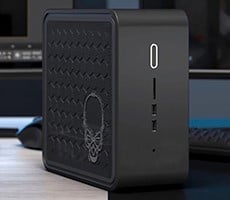Shuttle SB95P v2 SFF XPC
|
As we stated in the introduction, Shuttle's systems have typically been a bit boxy for some tastes, although that's not necessarily a bad thing. Rather than tinker with the shape, they have invested their efforts instead on sprucing up the faceplate and improving internal configurations and airflow routing. The chassis itself is constructed entirely of aluminum, serving a dual purpose: it keeps the weight of the system down and allows for quicker heat dissipation. Painted entirely in black, it perfectly offsets the gunmetal gray plastic overlays used on the face plating.
There are two drive bays and a front I/O panel concealed behind these retractable face plates. The frontside I/O panels includes audio jacks as well as two USB ports and one FireWire connection. Along the top, there's a sleek looking 8-in-1 card reader. All cards are inserted in a slot no larger than a typical credit card scanner, so it doesn't draw any undue attention to itself. It fact, when all bays are closed over, the only real break in the visuals comes from the chrome power button and a miniscule reset button underneath.
The backside of the SB95P is pretty much straight forward stuff port-wise. The major change with the 'P' chassis' is how hot air is removed in three zones using two fans along the top and one larger one from the power supply in the middle. An additional fan can be seen by peeking in the side grating, which is used as part of Shuttle's ICE technology. These zones are graphically displayed below, and are broken down as follows: the CPU zone, Power Supply and Graphics card zone, and the Hard Drive zone. Initially, air enters in along vents on the sides of the chassis as well as from the front of the unit. At the CPU, this cooler air is used to ventilate the heatsink and is sucked out the other side immediately. Readers may have noticed that the placement of the CPU socket is towards the front rather than the rear, which leaves the rear section entirely open. Excess heat from graphics cards, chips, etc. is moved out using two 60mm fans as well as by the fan on the PSU.

To get a closer look at how this all works, we opened up the SB95P and immediately saw how the placement of the heatsink towards the front really opened things up. First thing we did was remove the drive cage, which requires popping off two soft brackets. We could then look down directly at the heatsink, held down by four retention screws, and connected to some ductwork. At the other end was an 80mm fan designed to pull in air and blow it directly out the side of the chassis. As you can see, the rest of the motherboard is plainly visible, making it a breeze to install components without bumping into things and also helps keep the air moving about; particularly good for cooling the heatsink placed over the Northbridge. Power is supplied by a 350W SilentX PSU, which is both powerful (by SFF standards) and quiet. Booting the system using the original BIOS would cause the fans to rev up rather loudly at first, but a later revision corrected that problem for quiet operation throughout.
When we were discussing the bundle, we mentioned the relatively new screwless drive installation, and to be fair it works well in most cases. We did have a few problems that we wanted to bring to light, however, that some users may want to consider. The retention brackets on the drive cage were sometimes too easy to give way. While it made removal and installation of the cage easy, there were instances where we bumped the cage when installing other components that would pop the brackets right off. In the same vein, the 4-pin hard drive mechanism gave us a bit of trouble. Two metal stays run alongside the hard drive, and are supposed to keep the drive in place. In our setup, one of these broke loose from the chassis, and the hard drive would only sit on the pins, but could easily slide up off of them. There were also "radiation" shields that Shuttle recommended be installed, but these too would pop out of their moorings and bounce around inside the system. There's nothing worse than showing up for a LAN party, only to hear assorted pieces of metal banging around inside your PC. These are definitely some areas that Shuttle will need to improve on with future models.





















